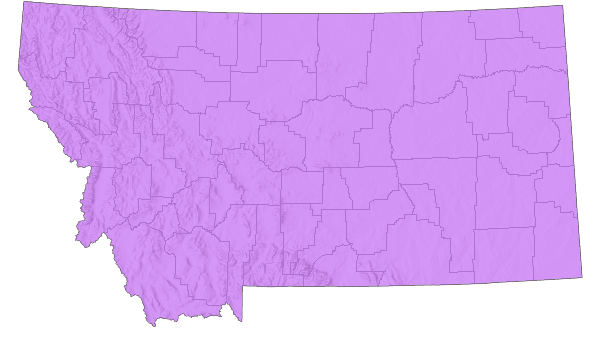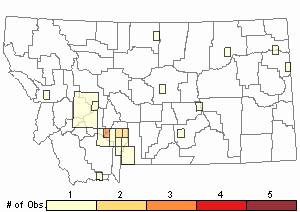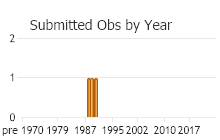View in other NatureServe Network Field Guides
NatureServe
Montana
Utah
Wyoming
Idaho
Wisconsin
British Columbia
South Carolina
Yukon
California
New York
Club-horned Grasshopper - Aeropedellus clavatus
General Description
The following is taken from Hebard (1928), Brooks (1958), Helfer (1971), Otte (1981), Capinera and Sechrist (1982), Vickery and Kevan (1985), McDaniel (1987), Pfadt (2002), Capinera et al. (2004), and Scott (2010). Adults possess club-shaped (clavate) antennae which are grayish-white to brown. Body color is gray, brown, or green. Each abdominal segment bears a dark patch. A vertical white stripe occurs on the lateral head side in front of the eye and the frons. Male wings (tegmina) extend to or beyond the abdominal tip, female wings are shorter, about half the length of the abdomen. Hind tibia is yellow to brown.
Phenology
Eggs begin to hatch from mid-May to early June. Adults become common from mid-July through September (Otte 1981, Capinera and Sechrist 1982, Vickery and Kevan 1985, McDaniel 1987, Pfadt 2002, Capinera et al. 2004, and Scott 2010).
Diagnostic Characteristics
The following comes from Hebard (1928), Brooks (1958), Helfer (1971), Otte (1981), Capinera and Sechrist (1982), Vickery and Kevan (1985), McDaniel (1987), Pfadt (2002), Capinera et al. (2004), and Scott (2010). The males’ body length is 16 to 20 mm and females is 18 to 25 mm. Three, median and lateral, definite dorsal ridges (carina) cut by a single sulcus occur on the pronotum (thorax) and are constricted inward at the middle. Male wings (tegmina) extend to or beyond the abdominal tip, female wings are shorter, about half the length of the abdomen.
Could be confused with the
Shasta Slant-faced Grasshopper (
Bruneria shastana), but the club-shaped antennae of
A. clavatus is diagnostic and easily confirms its identification from
B. shastana.
Species Range
Montana Range
Range Descriptions

 Native
Native
Range Comments
The following comes from Capinera and Sechrist (1982), Capinera et al. (2004), McDaniel (1987), Otte (1981), Pfadt (2002), Scott (2010), Vickery and Kevan (1985). Distributed widely in the northern states and western Canadian provinces, from western Minnesota and Iowa, to eastern Washington southward. Found in alpine areas of Arizona and New Mexico at altitudes up to 13,000 feet. In Montana, this species has been recorded in 38 counties, but probably occurs in many others, as it seems to be widely distributed across the northern Great Plains and into the western mountains of the state.
Observations in Montana Natural Heritage Program Database
Number of Observations: 25
(Click on the following maps and charts to see full sized version)
Map Help and Descriptions
Relative Density

Recency


 (Observations spanning multiple months or years are excluded from time charts)
(Observations spanning multiple months or years are excluded from time charts)
Habitat
Favors dry, sandy, grassy fields and pastures. At higher elevations it is found in alpine meadows and tundra. In some areas it is considered an alpine and boreal species (Capinera and Sechrist 1982, Capinera et al. 2004, McDaniel 1987, Otte 1981, Pfadt 2002, and Vickery and Kevan 1985).
Food Habits
Primarily feeds on a diversity of grasses and sedges in mixed grass-bunchgrass prairies and mountain meadows. At higher altitudes it also feeds on forbs, especially thistle (Cirsium spp.) (Capinera and Sechrist 1982, Otte 1981, Pfadt 2002, Capinera et al. 2004, and Vickery and Kevan 1985).
Reproductive Characteristics
The following is taken from Capinera and Sechrist (1982), Otte (1981), Pfadt (2002), Capinera et al. (2004), and Vickery and Kevan (1985). The Club-horned Grasshopper has an egg hatching period of 3 to 4 weeks. Nymphs pass through 4 instars which develop rapidly to the adult stage. Adult stages are reached in about 30 days on the plains and 42 days in alpine habitats after hatching. Females oviposit eggs amid the roots of grasses and sedges. Egg pods contain 3 to 8 eggs arranged in two rows. Studies indicate that eggs laid by populations in high altitudes pass through two winters before hatching, whereas those from lower elevations hatch after one winter.
References
- Literature Cited AboveLegend:
 View Online Publication
View Online Publication Brooks, A.R. 1958. Acridoidea of Southern Alberta, Saskatchewan, and Manitoba (Orthoptera). The Canadian Entomologist (Supplement 9) 90:5-92.
Brooks, A.R. 1958. Acridoidea of Southern Alberta, Saskatchewan, and Manitoba (Orthoptera). The Canadian Entomologist (Supplement 9) 90:5-92. Capinera, J.L. and T.S. Sechrist. 1982. Grasshoppers of Colorado: Identification, Biology, and Management. Fort Collins, CO: Colorado State University Experiment Station, Bulletin 584S. 161 p.
Capinera, J.L. and T.S. Sechrist. 1982. Grasshoppers of Colorado: Identification, Biology, and Management. Fort Collins, CO: Colorado State University Experiment Station, Bulletin 584S. 161 p. Capinera, J.L., R.D. Scott, and T.J. Walker. 2004. Field Guide to Grasshoppers, Katydids, and Crickets of the United States. Ithaca, NY. Cornell University Press.
Capinera, J.L., R.D. Scott, and T.J. Walker. 2004. Field Guide to Grasshoppers, Katydids, and Crickets of the United States. Ithaca, NY. Cornell University Press. Hebard, M. 1928. The Orthoptera of Montana. Proceedings of the Academy of Natural Sciences of Philadelphia, Vol. 80:211-306.
Hebard, M. 1928. The Orthoptera of Montana. Proceedings of the Academy of Natural Sciences of Philadelphia, Vol. 80:211-306. Helfer, J.R. 1971. How to Know the Grasshoppers, Crickets, Cockroaches, and Their Allies. Revised edition (out of print), Mineola, NY: Dover Publications.
Helfer, J.R. 1971. How to Know the Grasshoppers, Crickets, Cockroaches, and Their Allies. Revised edition (out of print), Mineola, NY: Dover Publications. McDaniel, B. 1987. Grasshoppers of South Dakota. Brookings, SD: South Dakota Agricultural Experiment Station, Bulletin TB 89.
McDaniel, B. 1987. Grasshoppers of South Dakota. Brookings, SD: South Dakota Agricultural Experiment Station, Bulletin TB 89. Pfadt, R.E. 2002. Field Guide to Common Western Grasshoppers, 3rd edition. Laramie, WY: Wyoming Agricultural Experiment Station, Bulletin 912, modified by S. Schell and S. Schell for electronic publication. Accessed 19 February 2020. http://www.uwyo.edu/entomology/grasshoppers/field-guide/index.html#fieldguidetoc
Pfadt, R.E. 2002. Field Guide to Common Western Grasshoppers, 3rd edition. Laramie, WY: Wyoming Agricultural Experiment Station, Bulletin 912, modified by S. Schell and S. Schell for electronic publication. Accessed 19 February 2020. http://www.uwyo.edu/entomology/grasshoppers/field-guide/index.html#fieldguidetoc Scott, R.D. 2010. Montana Grasshoppers, Katydids, and Crickets A Pictorial Field Guide to the Orthoptera. MagpieMTGraphics, Billings, MT.
Scott, R.D. 2010. Montana Grasshoppers, Katydids, and Crickets A Pictorial Field Guide to the Orthoptera. MagpieMTGraphics, Billings, MT. Vickery, V. R. and D. K. M. Kevan. 1985. The grasshopper, crickets, and related insects of Canada and adjacent regions. Biosystematics Research Institute, Ottawa, Ontario. Publication Number 1777. 918 pp.
Vickery, V. R. and D. K. M. Kevan. 1985. The grasshopper, crickets, and related insects of Canada and adjacent regions. Biosystematics Research Institute, Ottawa, Ontario. Publication Number 1777. 918 pp.
- Additional ReferencesLegend:
 View Online Publication
View Online Publication
Do you know of a citation we're missing? Anderson, N.L. 1951. Field studies on the biology of range grasshoppers of southeastern Montana. M.Sc. Thesis. Bozeman, Montana: Montana State University. 96 p.
Anderson, N.L. 1951. Field studies on the biology of range grasshoppers of southeastern Montana. M.Sc. Thesis. Bozeman, Montana: Montana State University. 96 p. Anderson, N.L. 1962. Grasshopper-vegetation relationships on Montana grasslands. Ph.D Dissertation. Bozeman, Montana: Montana State University. 73 p.
Anderson, N.L. 1962. Grasshopper-vegetation relationships on Montana grasslands. Ph.D Dissertation. Bozeman, Montana: Montana State University. 73 p. Gillespie, R.L.1992. Dynamics of grasshoppers (Orthoptera: Acrididae) at a rangeland-crop interference. Ph.D. Bozeman, MT: Montana State University. 111 p.
Gillespie, R.L.1992. Dynamics of grasshoppers (Orthoptera: Acrididae) at a rangeland-crop interference. Ph.D. Bozeman, MT: Montana State University. 111 p. Henry, J.E. 1969. Protozoan and viral pathogens of grasshoppers. Ph.D. Dissertation. Bozeman, MT: Montana State University. 153 p.
Henry, J.E. 1969. Protozoan and viral pathogens of grasshoppers. Ph.D. Dissertation. Bozeman, MT: Montana State University. 153 p. Kirk, K. and C.R. Bomar. 2005. Guide to the grasshoppers of Wisconsin. Madison, WI: Wisconsin Department of Natural Resources, Bureau of Integrated Science Services PUB-SS-1008. 154 p.
Kirk, K. and C.R. Bomar. 2005. Guide to the grasshoppers of Wisconsin. Madison, WI: Wisconsin Department of Natural Resources, Bureau of Integrated Science Services PUB-SS-1008. 154 p. Larson, D.P. 1996. Evaluation of sweep sampling as a method for determining grasshopper community composition on rangeland. M.Sc. Thesis. Bozeman, MT: Montana State University. 92 p.
Larson, D.P. 1996. Evaluation of sweep sampling as a method for determining grasshopper community composition on rangeland. M.Sc. Thesis. Bozeman, MT: Montana State University. 92 p. Mussgnug, G.L. 1972. The structure and performance of an adult population of Aulocara elliotti (Thomas) (Orthoptera, Acrididae) near Billings, Montana. M.Sc. Thesis. Bozeman, MT: Montana State University. 97 p.
Mussgnug, G.L. 1972. The structure and performance of an adult population of Aulocara elliotti (Thomas) (Orthoptera, Acrididae) near Billings, Montana. M.Sc. Thesis. Bozeman, MT: Montana State University. 97 p. Otte, Daniel. 1981. The North American Grasshoppers. Volume 1. Acrididae (Gomphocerinae and Acridinae). Harvard University Press. 275 pp.
Otte, Daniel. 1981. The North American Grasshoppers. Volume 1. Acrididae (Gomphocerinae and Acridinae). Harvard University Press. 275 pp. Sater, S. 2022. The insects of Sevenmile Creek, a pictorial guide to their diversity and ecology. Undergraduate Thesis. Helena, MT: Carroll College. 242 p.
Sater, S. 2022. The insects of Sevenmile Creek, a pictorial guide to their diversity and ecology. Undergraduate Thesis. Helena, MT: Carroll College. 242 p. Skinner, K.F. 1995. Plant and grasshopper community composition: indicators & interactions across three spatial scales. M.Sc. Thesis. Bozeman, MT: Montana State University. 144 p.
Skinner, K.F. 1995. Plant and grasshopper community composition: indicators & interactions across three spatial scales. M.Sc. Thesis. Bozeman, MT: Montana State University. 144 p. Wachter, D.H. 1995. The ecology of selected grasshopper species along an elevational gradient. M.Sc. Thesis. Bozeman, Montana: Montana State University. 59 p.
Wachter, D.H. 1995. The ecology of selected grasshopper species along an elevational gradient. M.Sc. Thesis. Bozeman, Montana: Montana State University. 59 p.
- Web Search Engines for Articles on "Club-horned Grasshopper"
- Additional Sources of Information Related to "Insects"





